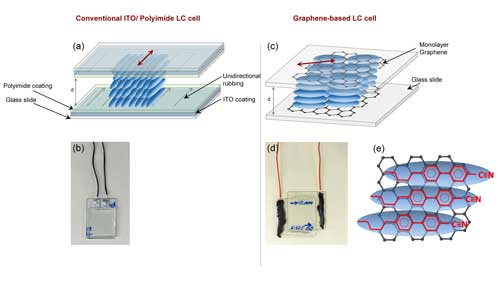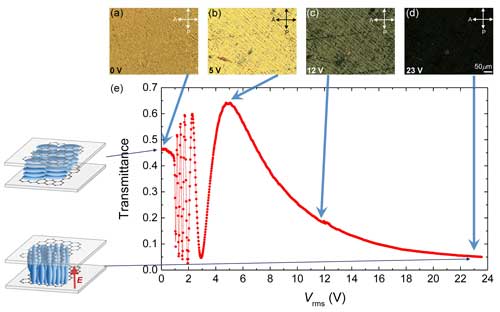| Posted: Jul 11, 2017 | |
Using graphene as transparent electrodes and alignment layers for liquid crystal devices |
|
| (Nanowerk Spotlight) Liquid crystals (LC) are technologically important for their wide applications in optical displays—known as liquid crystal displays (LCD). In conventional LCDs, the LC material is contained in conventional LC cells, where the polyimide layers are used to align the LC homogeneously in the cell, and the transmissive indium tin oxide (ITO) electrodes are used to apply the electric field to reorient the LC along the field. | |
| Associate Professor Rajratan Basu and his student Midshipman Samuel Shalov in the Department of Physics at the United States Naval Academy have experimentally demonstrated that monolayer graphene films on the two glass substrates can function concurrently as the LC alignment layers and the transparent electrodes to fabricate an LC cell, without using the conventional polyimide and ITO substrates. | |
| This replacement can effectively decrease the thickness of all the alignment layers and electrodes from about 100 nm to less than 1 nm. The transmission of the graphene film is more that of the ITO film. Reducing this effective thickness could offer the potential to minimize the transmissive losses and optimize throughput of light over a wide range of spectral bands for modern backlit LCDs. | |
| They report their findings in Physical Review E ("Graphene as transmissive electrodes and aligning layers for liquid-crystal-based electro-optic devices") | |
 |
|
| Figure 1: (a) A schematic representation of a conventional LC cell containing a layer of ITO and a layer of polyimide coating with unidirectional rubbing on each glass slide, (b) the picture of a conventional LC cell, (c) a schematic representation of a graphene-based cell which contains a single layer of graphene on each glass slide, (d) the picture of a graphene-based LC cell, (e) A schematic representation of the alignment of nematic LC molecules on graphene due to |
|
| "Graphene is a two-dimensional crystalline allotrope of carbon, where the carbon atoms are densely packed in a regular sp2-bonded atomic-scale hexagonal pattern," Basu explains to Nanowerk. "This two-dimensional material exhibits ballistic electron transport and high optical transmittance, and therefore, it can be used as transparent electrodes in various electronic devices." | |
| "The LC molecules can anchor to the honeycomb pattern of graphene, employing the π-π electron stacking (Fig. 1(e)) with a binding energy of -2 eV," he continues. "This strong LC-graphene interaction imposes a planar alignment on the LC in the graphene-based cell." | |
| Basu and Shalov show that the graphene-based LC cell exhibits an excellent nematic director reorientation process from planar to homeotropic configuration through the application of an electric field. | |
| Figure 2 represents the electrically-controlled birefringence effect of an LC in the graphene-based cell. | |
 |
|
| Figure 2: Electrically-controlled birefringence effect of E7 liquid crystal in the graphene-based cell. (a), (b), (c), (d) Micrographs of the graphene-based LC cell filled with E7 liquid crystal under the crossed-polarized microscope at 0 V, 5V, 12 V, and 23 V, respectively. (e) The transmittance, I/Io of E7 liquid crystal (T = 22°C) in the graphene-based cell as a function of applied ac voltage (f = 1000 Hz). The white bar in micrograph (d) presents 50 µm. (click on image to enlarge) | |
| Basu and Shalov observe that the electro-optic response time of the graphene-based cell is significantly faster than that of a conventional ITO/polyimide cell. The polar anchoring strength in the in the graphene-based cell is significantly enhanced due to the π-π electron stacking. | |
| In addition to that, graphene has the capability to trap mobile ions from an LC, reducing the rotational viscosity. Therefore, an enhanced polar anchoring strength and a reduced rotational viscosity lead to an accelerated electro-optic response in the graphene-based cell. | |
| "Thus, not only does the graphene-based cell exhibit excellent nematic switching, the switching itself is significantly accelerated in this device." Basu notes. | |
| "Presented results are expected to advance the conceptions about, and methodology toward, nanoscale manipulation LCs and LC orientation control using their interactions with graphene," concludes Basu. "These studies will not only make the liquid crystal technologically useful (i.e. faster switching), but will also directly lead to the central role played by the LC-graphene interaction at the nanoscale interface and its effect at the macroscopic level." | |
| This work was supported by the Office of Naval Research (Award No. N0001417WX01519) and the investment grant at the U.S. Naval Academy. | |
|
Provided by the U.S. Naval Academy as a Nanowerk exclusive.
|
|
|
Become a Spotlight guest author! Join our large and growing group of guest contributors. Have you just published a scientific paper or have other exciting developments to share with the nanotechnology community? Here is how to publish on nanowerk.com. |
|
